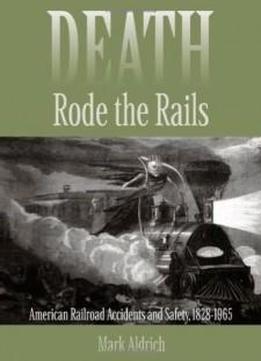
Death Rode The Rails: American Railroad Accidents And Safety, 1828-1965
by Mark Aldrich /
2006 / English / PDF
6.6 MB Download
For most of the 19th and much of the 20th centuries, railroads
dominated American transportation. They transformed life and
captured the imagination. Yet by 1907 railroads had also become
the largest cause of violent death in the country, that year
claiming the lives of nearly twelve thousand passengers, workers,
and others. In
For most of the 19th and much of the 20th centuries, railroads
dominated American transportation. They transformed life and
captured the imagination. Yet by 1907 railroads had also become
the largest cause of violent death in the country, that year
claiming the lives of nearly twelve thousand passengers, workers,
and others. InDeath Rode the Rails
Death Rode the Rails Mark Aldrich explores
the evolution of railroad safety in the United States by
examining a variety of incidents: spectacular train wrecks,
smaller accidents in shops and yards that devastated the lives of
workers and their families, and the deaths of thousands of women
and children killed while walking on or crossing the street-grade
tracks.
Mark Aldrich explores
the evolution of railroad safety in the United States by
examining a variety of incidents: spectacular train wrecks,
smaller accidents in shops and yards that devastated the lives of
workers and their families, and the deaths of thousands of women
and children killed while walking on or crossing the street-grade
tracks.
The evolution of railroad safety, Aldrich argues, involved the
interplay of market forces, science and technology, and legal and
public pressures. He considers the railroad as a system in its
entirety: operational realities, technical constraints, economic
history, internal politics, and labor management. Aldrich shows
that economics initially encouraged American carriers to build
and operate cheap and dangerous lines. Only over time did the
trade-off between safety and output—shaped by labor markets and
public policy—motivate carriers to develop technological
improvements that enhanced both productivity and safety.
The evolution of railroad safety, Aldrich argues, involved the
interplay of market forces, science and technology, and legal and
public pressures. He considers the railroad as a system in its
entirety: operational realities, technical constraints, economic
history, internal politics, and labor management. Aldrich shows
that economics initially encouraged American carriers to build
and operate cheap and dangerous lines. Only over time did the
trade-off between safety and output—shaped by labor markets and
public policy—motivate carriers to develop technological
improvements that enhanced both productivity and safety.
A fascinating account of one of America's most important
industries and its dangers,
A fascinating account of one of America's most important
industries and its dangers,Death Rode the Rails
Death Rode the Rails will
appeal to scholars of economics and the history of
transportation, technology, labor, regulation, safety, and
business, as well as to railroad enthusiasts.
will
appeal to scholars of economics and the history of
transportation, technology, labor, regulation, safety, and
business, as well as to railroad enthusiasts.











